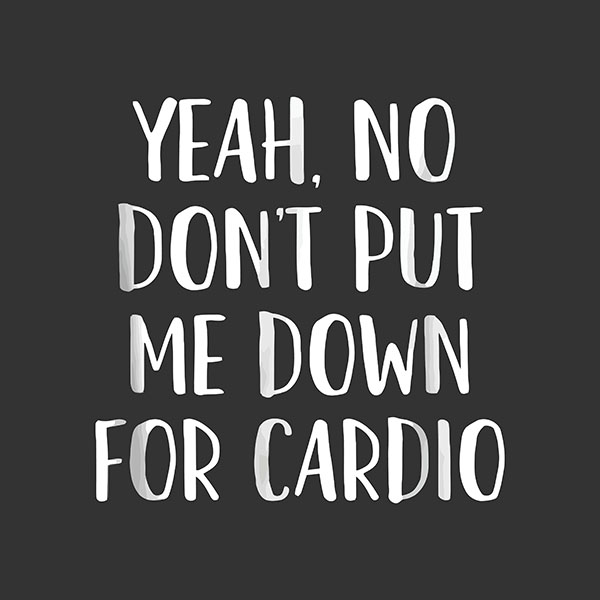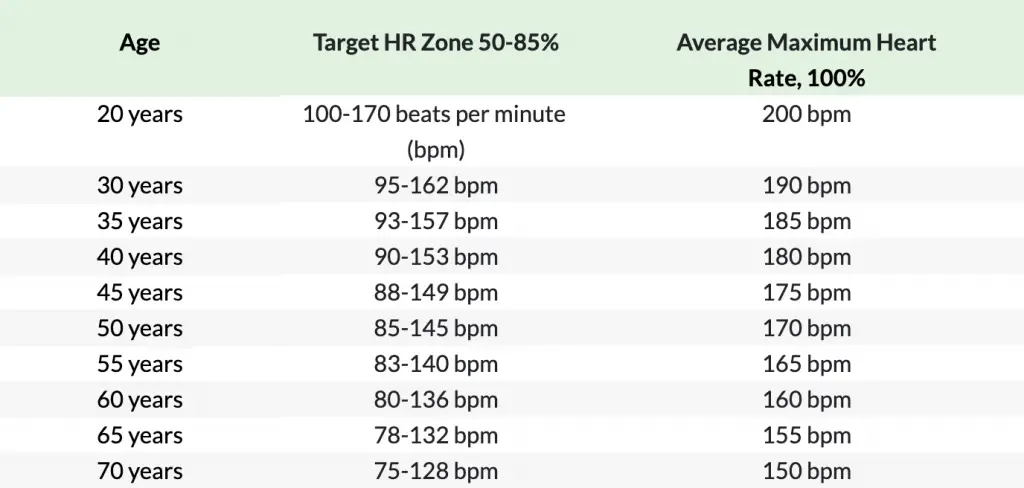Contents
How Much Cardio Is Too Much?
Did you know there are people out there who enjoy cardio? You read that sentence correctly. There are people who run, walk, hike, bike, swim…all for fun! In fact, I’m one of those people. You might think I’m crazy, but there’s no better way for me to start my day than by going for a 30-45 minute walk. Plus, it gives me an excuse to listen to a podcast episode without being bothered!
While you may not be one of those individuals who enjoys cardio, you should definitely engage in activities that get your heart rate up. Seriously, there are a variety of benefits that come along with cardiovascular exercise such as:
- Improves cardiovascular health by strengthening your heart, which helps it pump blood through the body more efficiently.
- It can help you manage and lower your blood pressure.
- Helps regulate insulin levels and lower blood sugar while simultaneously keeping your body weight in check.
- Cardio can help reduce chronic pain and may help get back muscle function and endurance.
- It aids sleep for those with chronic sleep issues.
- Aerobic exercise helps you lose weight and keep the weight off.
- It can increase antibodies in the blood known as immunoglobulins, which helps to strengthen the immune system.
- Cardio is good for improving brain power.
- It can help boost your mood.
- Cardio is affordable and accessible to pretty much anyone. There’s no gym required. All you need to do is get outdoors and walk or run!
The best benefit of cardio is that it’s good for your heart. However, there is such a thing as doing too much cardio. And the downside of doing too much cardio is not good at all. In fact, it can end up weakening or damaging your heart – which you definitely don’t want to happen. So, how do you know how much cardio is too much?
8 Ways To Know You’re Getting Too Much Cardio
 1. Joints Hurt
1. Joints Hurt
Are your joints constantly aching? There are quite a few high impact cardio exercises that can be rough on the joints. Let’s take running, for instance. When running you land hard on the joints throughout your feet and legs, which can lead to joint pain. If you continue to overdo it, the joints will be stiff, sore and aggravated. Obviously this can lead to a damper in your workout regimen, which you want to avoid. So, if your joints are aching, then avoid cardio for a while until you have healed up.
2. Always Sore
Are you stretching before and after workouts, but still feel sore? If your body constantly seems sore, then maybe you are doing too much cardio. Please understand – a little muscle fatigue is normal and a good thing. However, if you find that you’re constantly sore, then it’s a sign from your body that it’s time to take a chill pill. When your body talks to you, you need to listen!
3. Always Tired
This is my telltale sign that it’s time for a break on the cardiovascular activities. There have been days where I just can’t seem to shake the feeling of being tired. When I say tired, I mean tired for days on end. But I still forced myself to go on that run or do a heavy jump rope workout. Don’t be like me! If you find yourself always tired and no amount of rest is enough, then it’s time to reevaluate the amount of cardio you have been doing. In fact, it’s probably time to give yourself a rest day. Your body will thank you and you will feel the benefits of that!
4. Dreading Your Workouts
This is another one of those that I’m going to need you to pay attention to. Dreading a workout because you just don’t feel like working out is one thing. But dreading your workout because there’s so much cardio involved is different. It’s understandable to dread running a mile or two now and then. However, if you are dreading your workout every day because of the cardio involved, then chances are you’re doing too much.
 5. Not Losing Fat
5. Not Losing Fat
Talk about aggravating… Imagine doing cardio every day, but that stubborn fat is sticking around. You would think doing cardio would have the opposite effect. However, doing too much cardio means you could hurt more than helping. According to personal trainer, Dave Smith: “The positive fat-burning effects of cardio exercise are short-lived. Once you stop exercising, your body’s metabolism quickly returns to its normal state. If cardio is your go-to exercise, then you must force yourself to do more and more to see ongoing weight-loss results.”
6. Can’t Sleep
Yes, a benefit of cardio is sleeping better. However, a disadvantage of too much cardio is that it can cause sleeping issues. Research shows that too much exercise can increase your stress hormones like cortisol. Then once bedtime rolls around, so are you! If you can’t seem to sleep at night, then try taking a break on the cardiovascular exercises and see if that helps.

7. Losing Muscle
Do you feel you are kicking your bum every single day? But somehow you are losing muscle tone?
Dave Smith explained the following in a Huffington Post article: “Using cardio exercise as your primary form of exercise can ‘shrink’ your body but still leave you with a soft, undesirable physique. Your body composition (i.e. the ratio of fat to lean tissue) determines the shape your body takes. Reducing your body fat while simultaneously reducing your lean muscle tissue, may prevent your body composition from changing at all! In other words, all that work on the treadmill might make your body into a smaller version of what it was before instead of completely revamping your body’s shape. This can be a frustrating side effect of doing too much cardio exercise.”
8. Constantly Training for a Marathon
Running a marathon is definitely something you should pat yourself on the back for – multiple times! However, if you are constantly training for a marathon, then you’re probably doing a bit too much cardio. In fact, a study by the Mayo Clinic found that there are potential adverse cardiovascular effects from excessive endurance exercise. If you are constantly stressing your heart by going for long runs, swims or biking, then you’re not allowing your heart time to recover.
 Training Options other than Cardio
Training Options other than Cardio
If a lightbulb has suddenly gone off in your head and you realize there’s a good chance you have been doing a bit too much cardio, there are other options. That’s right! This doesn’t mean that your days of working out are over. Good try, though! In fact, there are several ways to continue your workout regimen that you may find help you get those desired results better than those intense cardio exercises.
Strength Training
Try incorporating strength training into your workout routine. Strength exercise, also known as resistance training, is when you work your muscles by using resistance. We can add resistance to workouts through resistance bands or through weights. Strength training exercises have shown to increase muscle mass and can help you burn more calories. A few of the basic strength training exercises include: squats, lunges, pushups, pull-ups and bicep curls.

Not to mention strength training comes along with its own variety of health benefits including:
- Increases muscle mass
- Increases bone density and reduces risk of fractures
- Helps the joints stay flexible and can reduce symptoms of arthritis
- Makes it easier to control weight
- Increases flexibility and balance
Yoga
Not that I’m biased, but my favorite form of working out is definitely yoga. Yes, there are a variety of physical benefits, but the mental benefits are phenomenal! Yoga is great for stretching and restoring the body. If you enjoy doing cardio like I do, then yoga will help reverse the effects of too much cardio on the body.

If yoga isn’t a part of your workout plan, then it’s time to add it because you are only doing yourself an injustice. Benefits of yoga include:
- It decreases stress levels by lowering cortisol levels
- Helps relieve feelings of anxiety and helps aid feelings of depression
- Reduces inflammation
- Improves heart health
- Improves quality of life
- Helps increase better quality of sleep
- Improves flexibility and balance
- Helps improve breathing
- Can help ease migraines
- Helps promote healthier eating habits
- Increases strength
How Much Cardio Do You Need?
You may feel you are at a bit of a crossroads here now. You started off this article thinking: “there’s no such thing as too much cardio.” Or, you may now feel you have an excuse to veto cardiovascular exercise from your workout regimen. So, instead I’m here to hit you with the facts straight from heart.org on what the cardio recommendations are.
Minutes per week
According to heart.org, you should get at least 150 minutes per week of moderate intensity aerobic activity or 75 minutes per week of vigorous aerobic activity. Or you can do a combination of both. It says that you should spread out your aerobic activity through the week. So, perhaps you do cardio on Mondays and Wednesdays or Tuesdays and Thursdays. Whatever plan works best for you! But it is definitely something to take into consideration.
Calculate Target Heart Rate
Now, let’s talk about calculating your target heart rate. Knowing what your target heart rate should be is the best way to get the most out of the exercises you are doing! According to the Mayo Clinic, you can calculate your maximum heart rate by subtracting your age from 220.
The website says: “For example, if you’re 45 years old, subtract 45 from 220 to get a maximum heart rate of 175. This is the average maximum number of times your heart should beat per minute during exercise. Once you know your maximum heart rate, you can calculate your desired target heart rate zone — the level at which your heart is being exercised and conditioned but not overworked.”

The American Heart Association recommends a target heart rate of:
- Moderate exercise intensity: 50% to about 70% of your maximum heart rate
- Vigorous exercise intensity: 70% to about 85% of your maximum heart rate
There are online calculators that can help you discover what your desired heart rate should be. Or you can always do the math yourself. Here’s how:
- Subtract your age from 220 to get your maximum heart rate.
- Calculate your resting heart rate by counting how many times your heart beats per minute when you are at rest, such as first thing in the morning. It’s usually somewhere between 60 and 100 beats per minute for the average adult.
- Calculate your heart rate reserve (HRR) by subtracting your resting heart rate from your maximum heart rate.
- Multiply your HRR by 0.7 (70%). Add your resting heart rate to this number.
- Multiply your HRR by 0.85 (85%). Add your resting heart rate to this number.
- These two numbers are your average target heart rate zone for vigorous exercise intensity when using the HRR to calculate your heart rate. Your heart rate during vigorous exercise should be between these two numbers.
Give it Rest
Your heart is undoubtedly your most important organ in your body. Therefore, taking care of it should be one of your top priorities. It’s definitely not a task you should take lightly or something that you “keep pushing” to see its limits. Just like all of your other muscles, the heart needs rest. Be diligent about giving it what it needs. Learn from this article and you will know how much cardio is too much. The better care you take of your heart, the better care it will take of you!
